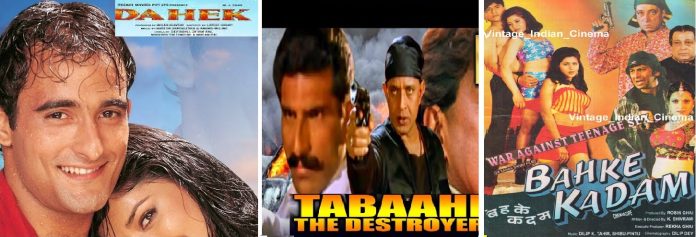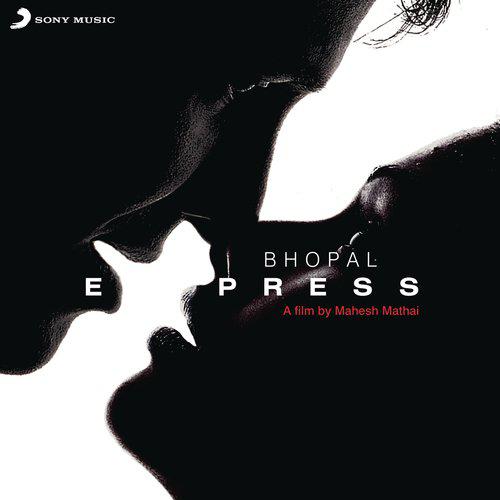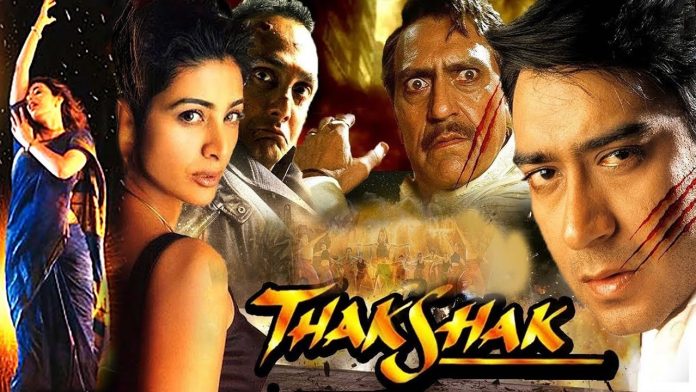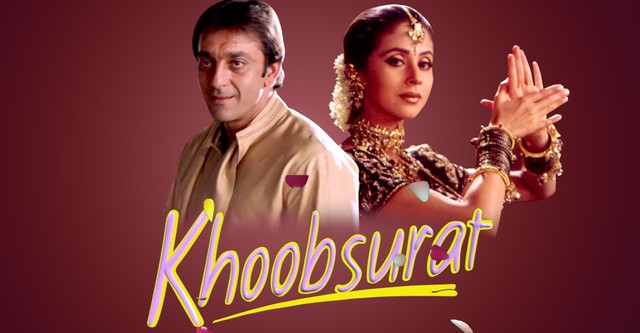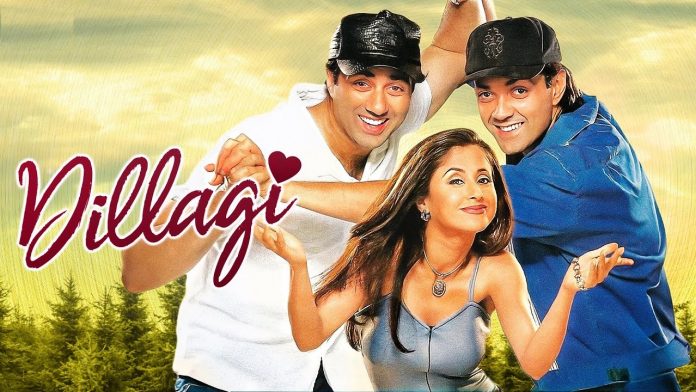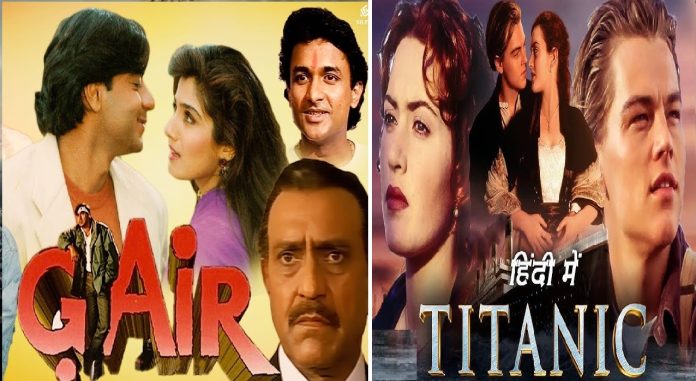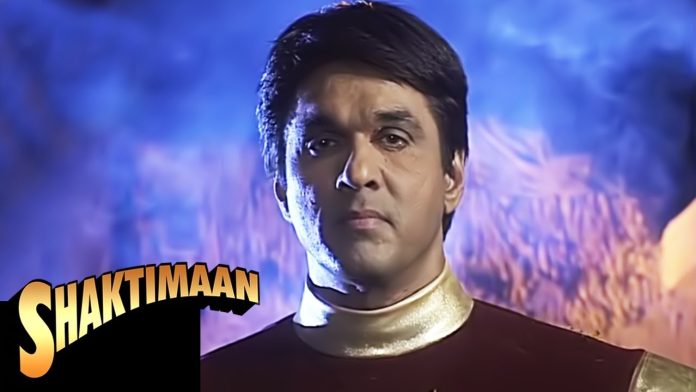HUM SAATH-SAATH HAIN
Rajshri Productions (P.) Ltd’s Hum Saath-Saath Hain is a heartwarming family drama inspired from the epic, Ramayan. True to the Rajshri tradition, the film is a neat and clean enterprise soaked in emotions for all age groups.
The story advocates the joint family system and the reasons why the subject will appeal to the viewers in today’s times, when the joint family system is giving way to the nuclear family system, are manifold. For one, it talks of the virtues of the system and lets those audiences, who cannot experience the joys of the joint family system in real life, live in the world of fantasy for three hours. Secondly, it conveys the message through a light drama that takes a serious turn, but never preaches. Thirdly — and most importantly — the film propagates values of yore (which may not be practical to follow today) with such honesty, integrity and sincerity that the viewer doesn’t once want to question the practicality of the drama. The truthfulness of the story, screenplay and treatment will greatly appeal to the ladies and family audience.
The story revolves around a family of a happily married couple which has three sons and a married daughter. The eldest boy is the lady’s step-son while the younger two and the daughter are her own biological children. All hell breaks loose in the happy and prosperous family when the otherwise noble mother becomes a victim of loose talk and decides to divide the family properties among her three sons, to avoid any future tensions and differences between them. The three sons and their father are shocked by the decision of the mother/wife and try to change her mind, but she refuses to budge from her stand which ultimately breaks the happy joint family. The step-son, rather than let the family wealth be divided, opts to leave the family home, alongwith his wife. He has the sympathy of the entire family and all the relatives except the step-mother. The culture and upbringing, however, prevent all of the three sons from revolting against their mother although the younger two amply show their dissatisfaction. Ultimately, the mother realises her folly, repents for her harsh decision and makes amends.
The film’s first half is light and fast-paced, filled with fun and frolic. Although it reminds of the same director’s Hum Aapke Hain Koun..!, it has its own freshness too. The interval point, however, is weak. What is heartwarming about the first half is that even despite the fun, there are moments which bring tears of joy to the eyes of the viewers.
The second half is emotionally surcharged. Once the drama begins, it’s an emotional journey till the end. While the younger generation may not really adore the sentimental scenes, the womenfolk and the family audience will be simply floored by the tear-jerking moments. Sooraj Barjatya’s screenplay deserves distinction marks. Every scene has been painstakingly thought of so that the epic story is given a contemporary look. The little nuances to activate the tear ducts of his audience are aplenty and simply great! For instance, the scene in which the eldest son’s disabled hand is given support by his wife in the wedding mandap, the scene in which he and his wife leave their home with not so much as a frown on their foreheads, the scene in which the sister tells her mother how the step-brother had embraced all her miseries as his own, the love between the three child artistes, the climax scene between the mother and her step-son in the hospital are but a few of the brilliant scenes written with the masterly stroke of Sooraj’s pen. Dialogues complement the screenplay beautifully and are absolute gems.
Hum Saath-Saath Hain is the writer-director’s film all the way. Sooraj R. Barjatya narrates his script with a rare brilliance. The drama does take a dip at a couple of places in the second half but for a few minutes only. Otherwise, Sooraj’s direction is as extraordinary as his writing. Every shot in the film has the unmistakable Sooraj stamp!
Salman Khan has been cast in a different role. Playing the middle brother, who is reserved and shy, he does an exemplary job, not going overboard even once. His “mummy” dialogue will be loved by the youngsters. Yes, his reserved character may be resented by Salman’s hardcore fans but that’s a risk Sooraj seems to have taken. Karisma Kapoor plays the youngest brother’s girlfriend beautifully. She and Saif Ali Khan (the youngest brother) play to the gallery and the two will be loved by the masses and the youngsters. Their cute chemistry and playful skirmishes work beautifully and they provide many light moments in the film. The scene in which the two are lost in their dreams is brilliantly conceived and it will bring the house down with applause. All said, if Karisma is brilliantly spontaneous, Saif is spontaneously brilliant. Tabu, as the eldest brother’s wife, is required to wear a serene and contented look and she does so marvellously. She may not have many dialogues to deliver but her expressions are just too fantastic. Mohnish Bahl plays the eldest brother with elan. He is as natural as natural can be and wins the audience over with his sheer simplicity and honesty. He plays his character with the fullest sincerity. Sonali Bendre looks beautiful and she, too, has few dialogues to deliver. She is mostly required to blush, as Salman Khan’s to-be wife, and she endears herself to the audience with her coyness. She stands out in the scene in which she comforts an emotionally distraught Salman and succeeds in making him eat food. Neelam plays the loving sister perfectly. She makes the audience weep a couple of times because of her natural performance. Mahesh Thakur is very good. Alok Nath is excellent, as always. Reema acts wonderfully as the mother. Satish Shah is lovable. Sadashiv Amarapurkar raises laughter. Rajiv Verma leaves a mark. Shakti Kapoor does a fine job. Ajit Vachhani is very effective. Himani Shivpuri gives the perfect expressions at the proper time. Jayshree T., Kalpana Iyer and Mallika (Kunika) play the wicked threesome ably. Dilip Dhawan, Shammi, Sheela Sharma, Huma Khan, Achyut Potdar, Jatin Kanakia and the three child artistes (playing Mahesh Thakur’s daughter and nephews) lend wonderful support.
Raamlaxman’s music has melody, and the songs, though not of the super-hit quality, have it in them to grow on the listener. ‘Mhare hivda mein naache mor’ is the best number and it has been well picturised. ‘ABCD’ and ‘Maiyya Yashoda’ are also well-tuned songs. ‘Yeh to sach hai’ has immense lyrical value. ‘Suno ji dulhan’ is a good item number but is a bit lengthy. Song picturisations should have been better.
Rajan Kinagi’s camerawork is of a very high standard. The film looks colourful and has an eye-pleasing quality about it. Sets (Bijon Dasgupta) are lovely. Production values and costumes of artistes are grand, lavish, gorgeous and tasteful. Background score is superb.
On the whole, Hum Saath-Saath Hain has opened to very dull houses, but it has the content, the emotions, the comedy, the almost flawless narration, the performances and the inherent honesty to pick up phenomenally by word of mouth. It will meet with mixed reactions initially, but will be simply adored, especially by ladies and families, and ultimately prove a super-duper hit. Its dull opening is due to pre-Diwali, lack of publicity (despite the very large number of prints released), its genre (family drama) and the music not having become a hit.
Released on 5-11-’99 at Liberty and 27 other cinemas of Bombay thru Rajshri Pictures P. Ltd. Publicity: below the mark. Opening: fair (also due to excessive number of prints). …….Also released all over except in Assam and Andhra. Opening was dull everywhere except at Chandrapur (Jayant cinema 1st day 43,053/-, city record).
SHOOL
Dream Merchants Enterprise’s Shool (A) is a terse comment on politics in the country today, taking Bihar as an example. A young, upright police officer is posted in a town of Bihar where the mafia rules, and even the police officers are mere bootlickers. The newly-posted police officer feels like fish out of water in this scheme of things and, being a conscientious custodian of law, tries all he can to rectify the situation. He takes on the local MLA and attempts to put an end to his criminal activities and the atrocities perpetrated by him on the commoners. In trying to correct the scene, he loses his only daughter who is killed in one of the several encounters he has with the goons. He is also suspended from his job by his superiors. He is not supported by his own colleagues except one, who is one with him but does not have the courage to openly support him.
The suspended police officer’s frustration level reaches a flashpoint when even his wife dies in front of his own eyes. Ultimately, he cares not for what would be in store for him and seeks revenge on the MLA who was the starting point of all his miseries. He, therefore, succeeds in his own way in fighting the system.
The drama has a natural look and rarely, if ever, meanders. But its authenticity is also the film’s weak point because in maintaining genuineness, the drama becomes so grim that it keeps the viewer seeped in tension all through. The gimmicks of the villain (MLA) are designed to create light moments but they hardly have the desired impact. The comedy has a weird streak to it. In that sense, writers E. Nivas and Ram Gopal Varma have failed to make the film engaging enough. The morbidity of the drama also makes the film less appealing for the ladies audience.
Shool reminds of Ram Gopal Varma’s own Satya but is less than that film in all respects.
Manoj Bajpai does a remarkable job as the upright police inspector. He lives his character and makes the viewer cry for the sheer intensity of his performance in emotional scenes. His facial expressions are simply extraordinary. Raveena Tandon has a brief role (of Manoj Bajpai’s wife) but she stands out with a natural performance. Sayaji Shinde does well as the villain, but in some scenes only; in others, he overacts. Baby Alvi is fair. Shri Vallabh Vyas, Vineet Kumar, Ganesh Yadav, Virendra Saxena, Yashpal Sharma and the others lend admirable support. Shilpa Shetty leaves a mark in a song-dance sequence.
E. Nivas’ writing and choice of subject may leave something to be desired but he shows promise as a director with this debut film of his. His shot takings are effective. Music is dull except for the Shilpa Shetty number. Camerawork (Hari Nair) complements the film’s mood admirably. Action scenes (Amin Ghani) are extremely natural. Dialogues (Anurag Kashyap) are praiseworthy. Sandeep Chowta’s background score is effective. Technically, of a good standard.
On the whole, Shool may benefit for a couple of days during the festival holidays but, otherwise, has dim chances because of its grim content. Even otherwise, it remains, at best, a film for good cinemas of some ‘A’ class centres mainly.
Released on 5-11-’99 at New Empire and 19 other cinemas of Bombay thru Devgan Entertainment & Software Ltd. Publicity: very good. Opening: ordinary (affected due to pre-Diwali). …….Also released all over (in several centres, it will be released on 7th/8th). Opening was dull almost everywhere.
MADHURI DIXIT WEDS
Top actress Madhuri Dixit got married in Los Angeles to a student-doctor based there, on 17th October. Shriram Nene is studying to become a heart surgeon and is based in the United States.
GOLDIE CINEMA, AURANGABAD INAUGURATED
Goldie, the first air-conditioned cinema of Marathwada region, was inaugurated on 4th November in Aurangabad at the hands of the city police commissioner, Shripad Kulkarni. Among the guests who graced the function were collector Chehal, film artistes Pooja Batra, Moon Moon Sen, Sudesh Berry and Rajesh Shrivastav. Owner Deepak Jawaharani presented mementoes to the guests and also hosted a cocktail-dinner party which was attended by local distributors and exhibitors and Nizam film distributors. For the Marathwada film trade, a party in the midst of film stars was a unique experience.
The cinema opened with Hum Saath-Saath Hain.
HIGHEST EVER!
Rajshri’s Hum Saath-Saath Hain has been released with a record number of 405 prints in India and Overseas. Another 37 prints are ready and they will be released on 8th/12th November. This is the highest ever number of prints for any film’s premiere release so far.
This release strategy is in direct contrast to that adopted by Rajshri for its Hum Aapke Hain Koun..! which had opened with 30 prints. The prints were gradually increased then. Finally, about 600 prints of HAHK..! had been taken out.
Of the 405 prints of HS-SH released this week, 121 have been released in Bombay and 121, in the Overseas. The film has opened in every circuit except Assam and Andhra. In the latter territory, the dubbed Telugu version of the film will be released and hence the Hindi version has not been opened.
The break-up of prints circuit-wise: Bombay city & suburbs 32; Maharashtra 37; Gujarat 36; Saurashtra 11; Bombay-Karnataka 3; Goa 2; Delhi-U.P. 32; East Punjab 14; West Bengal 21; Bihar 14; Orissa 1; C.P. Berar 21; C.I. 18; Rajasthan 13; Nizam 21; Mysore 7; Tamilnad 1; Overseas 121.
BABY GIRL FOR SANJAY KAPOOR, MAHEEP
Maheep, wife of Sanjay Kapoor, delivered a baby girl on 2nd November at Breach Candy Hospital in Bombay. This is the couple’s first child.
DOLBY DIGITAL DTS AT TARAKARAMA 70MM, HYDERABAD
Tarakarama 70mm cinema in Hyderabad has been renovated and is now equipped with Dolby Digital DTS sound system. The cinema has the distinction of screening the Amitabh Bachchan starrer, Don, continuously for 525 days in regular shows! Several Telugu films have also celebrated silver and golden jubilees at the cinema.
3-E
Education-Entertainment-Enlightenment
Manoj Kumar’s ‘Millennium Sense’
While one Manoj (Manoj Night Shyamalan) has made a Hollywood super-hit, The Sixth Sense, our very own Manoj Kumar has made a super-hit observation. According to him, “The century (in the film industry) started with Raja Harishchandra and it concludes with a Ramayan — that is to say, with Rajshri’s Hum Saath-Saath Hain“!
‘Novelty’ Of Novelty Cinema, Lucknow
With the release of Hum Saath-Saath Hain, Novelty cinema of Lucknow has introduced an element of novelty. The cinema is issuing demand drafts, not to the distributors, but to those booking tickets to see HS-SH at the cinema. These demand drafts are actually tickets which look like DDs.
Diwali And Films With Long Titles
For several years now, Diwali has been dominated by films with four-word titles. Like Hum Saath-Saath Hain has been released this Diwali, there were two four-worded films last Diwali. They were Kuch Kuch Hota Hai (KKHH) and Bade Miyan Chote Miyan (BMCM). In 1997, it was Dil To Pagal Hai (DTPH) and in 1995, Diwale Dulhania Le Jayenge (DDLJ).
Saat-Saat, Saath-Saath!
Gair, which was launched in 1992, is releasing this week — on 8th November — after seven years. Maa Kasam, started seven months back, has also been released this week (5th November). Despite one taking seven years to release, and the other taking seven months, both the film have been released saath-saath with Hum Saath-Saath Hain!
Tough Time For Touring Talkies In Maharashtra
Touring talkies in Maharashtra are in a state of panic. The state government has decided not to let those touring talkies continue at the same place which have been there for 10 years or more. The cinema will have to apply for new licences also. The authorities seem to be interpreting the word ‘touring’ and are, therefore, taking the touring talkies’ being ‘stationed’ at one place with a pinch of salt. The ones panicking alongwith the touring talkies are the sub-distributors of Maharashtra, who acquire films from the main distributors, mainly because the touring talkies are a good outlet for them to release the films. The Miraj-Sangli area alone reportedly has over 70 touring cinemas. Umras, a small centre, till recently had four touring talkies. Of these, one got converted into a permanent cinema.
GENERATION GREATS
B.R. Chopra, Subhash Ghai, Karan Johar On Film-Making Yesterday, Today And Tomorrow
Filmmaking as a process has undergone myriad changes over the years. What may have been unthinkable in terms of content in a film thirty years ago may be quite normal today. What may have been unachievable for a producer or director four decades ago may have become a necessity in a film at the close of the 20th century. The problems of filmmakers have also been different at different times.
To get an insight into all these issues and much more, Information decided to bring three generations of filmmakers together. The names had to be of three tops. And so we met B.R. Chopra, Subhash Ghai and Karan Johar on the afternoon of 26th October in the spacious cabin of Chopra Sahab in his office at Santacruz, Bombay. Even the clothes they wore were representative of the fact that they came from three different generations. B.R. Chopra, who made his debut as a director with Afsana in 1951, was in a cream-coloured safari suit; Subhash Ghai, whose direction career started with Kalicharan in 1976, came in blue jeans and a matching jeans shirt. The youngest of them, Karan, who arrived on the scene in 1998 with Kuch Kuch Hota Hai, was more trendy — jeans, a grey T-shirt and a plain white unbuttoned shirt over it.
But their ages and clothes weren’t the only things that gave away the fact that the three were from different generations. The entire discussion, which went on for over an hour-and-a-half, also bore testimony to their ‘generation gap’ — a ‘gap’ Information tried to bridge, in this Diwali Exclusive.
Before the actual discussion started, Subhash Ghai asked B.R. Chopra whether, those days, music used to be released before the release of the film or with the film.
B.R. CHOPRA: It wasn’t released before. It was only with the film’s release that the music used to be released. Music used to be an integral part of the film. In those days, HMV used to release the music with the film’s release.
SUBHASH GHAI: So, it was never 2-3 months before, like it is done today?
B.R. CHOPRA: Today, the whole thing is based on business. If the music is good, it is sold. That time, there was no question of music being bad, it was like the dialogues of a film…..
KARAN JOHAR: …..Yes, it was meant to move the film ahead…..
B.R. CHOPRA: How would a song like Chalo ek baar phir se ajnabi ban jaaye (Gumrah) be understood by the people without visuals? Only when the audience saw the song in the form of a scene, it became popular.
KARAN JOHAR: The concept of the music is to move the screenplay ahead, which stopped happening after the ’70s.
B.R. CHOPRA: If you go to see, the concept has completely changed. The songs do not come by any kind of mathematics. They are brought in because it is required to do so. But there is one thing which I find strange — I don’t know whether I should comment on it as I have not made a film for the last ten years. What I find strange is, whenever a boy and girl start singing a love song, there are 20-30 couples dancing to the tune of the same song in the background……
KARAN JOHAR: …..Not 20-30, there are 100 couples nowadays! (Everybody has a hearty laugh)
B.R. CHOPRA: But this thing continues to be there. If it is liked, it is liked by the people. After all, your main aim is to appeal to the people. So, I don’t want to say anything against it…..
In those days (points out to the framed photograph on his table which shows five great filmmakers: Bimal Roy, Mehboob Khan, Raj Kapoor, K. Asif and B.R. Chopra), besides these people, there were Wadia and Mohan Studios, who also used to make entertaining films and people used to like their films, too. Only, the people’s psychology has changed today.
FILM INFORMATION: So shall we begin? Firstly, we are going to talk to you as generations of filmmakers, not individually. Some questions are, of course, typical or particular to you. Otherwise, they are addressed to your three generations.
Let’s start with you, Subhash-ji, because you are the link between Chopra Sahab’s generation and the new generation, as represented by Karan. How do you look at films of yesteryears and those of today?
SUBHASH GHAI: I have seen Indian cinema in three phases. First, when I was very young, say about 16 to 18 years, and then as a student of the film institute and when I was doing plays on the stage. At that time, I used to see B.R. Chopra Sahab’s films like Naya Daur along with films of Mehboob, Bimal Roy, Raj Kapoor, Guru Dutt. Their films had a great effect on me and I learnt a lot on my own, as a student. Then I joined the film institute. And then, when I came into the film industry, there were a lot of South Indian films being made by A. Bhimsingh, T. Prakash Rao, L.V. Prasad. So, I saw South kind of Hindi films also, like AVM and other banners. They used to make social films. They were cinematically strong filmmakers like Mehboob Khan and Raj Kapoor. But B.R. Chopra Sahab always used to make films related to social issues and his films used to interest me a lot because his movies had gloss as well as a strong social content. At that time, a large chunk of the audience used to comprise the middle-class people. That’s why Pyaasa, Gumrah, Naya Daur and some other films of this kind did well. But when I joined the film industry as a struggler and started directing a film, at that time, I saw a very horrid phase when action dominated films.
B.R. CHOPRA: So, action had come?
SUBHASH GHAI: Yes, action had already come. Amitabh Bachchan was born, Shammi Kapoor and Rajesh Khanna were fading out. I did not know how to adjust myself to the changed scenario. To survive, I had to start with a crime thriller like Kalicharan followed by Vishwanath and other films. I thought to myself that probably what I was making was contemporary cinema. But I could see the degeneration setting in. In my heart of hearts, I had great regard for movies made by B.R. Chopra, Mehboob, L.V. Prasad and the like. In the ’70s and ’80s, I could see, anybody was making anything. Unfortunately, in the ’80s, the business of cinema went down due to the opposition of TV and rise in video piracy. The period was very bad. We were discouraged about the whole thing. And Yash-ji (Chopra) was also discouraged about the whole thing. Anyway, we could survive. Kahin na kahin, chakkar chalanewali baat thi, but we were never happy with it. I was happy making Karz but the film did not do well. Karz did well only in metro cities. I became happy only in 1991 when the third phase came, when I saw the coming of television serials and shows. Then the content and the form of films was emerging stronger. People wanted a change. An optimum balance of content and form came into being. After Saudagar and Khal-nayak, I could see the coming of a new generation like Sooraj Barjatya, Aditya Chopra and Karan, who give importance to the content as well as the look of the film. Now, one can see any kind of cinema on the internet. Technology has advanced. People are more conscious of good photography and the aesthetics. This marked the end of the action and horror era of the ’80s. And I am also happy about one thing — that all those suppressions, I was subjected to in those days, are not there anymore. Chopra Sahab, I used to write beautiful scenes, but then, I had to change them and I had to suppress my creatively conceived lines, only because I used to ask myself, ‘How will the domestic servant understand this scene? How will the tangewala appreciate the beauty of the scene?’ I used to stoop down, try to make those scenes hard, harsh and direct, badtameez kar deta, scene ko. Today, I have a chance to express my thoughts without all those inhibitions, and with a certain degree of sophistication.
FI: Is it because the structure of the audience has changed today?
SUBHASH GHAI: Yes. I will give full credit to the medium of television and information technology, due to which people have developed a sense of drama and aesthetics. I am talking about the middle-class and lower middle-class people. And they have understood the magic of watching a film in a cinema hall and feeling the effect. Now they also want rich content in films. Their demands have become very tough. The content has to be better than what they get to see in TV serials. It is essential today that films should be strong cinematically and content-wise, too. That’s why these young directors have rejected the cinema of the ’70s and the ’80s. They have very wisely adopted the content of the ’50s and the ’60s, and have given a new expression to it, in keeping with today’s times. Our culture is the same, our family values are the same, so there is no big change where content is concerned. We will not show a son slapping his father. That will never be accepted.
FI: Chopra Sahab, what is the one single most dramatic change you have noticed in the films made in your times and now?
B.R. CHOPRA: In my time, I used to look for a story first. But today, it is not so. When I was only 19 or 20 years old, that is, when I was doing my B.A., I used to write articles. There was a paper called ‘Varieties’ which was conducted by New Theatres. They once asked me to write an article, ‘Around the Indian Screen’, in which I pointed out that this was not the way to make films. There are so many things to say, so many problems and issues of our society, which need to be tackled. Why don’t you make films on issues?, I asked in that article. Now, we have once again come back to the same stage today. Today, we do not want to make issue-based films. People are not concerned about tackling any problem. They are only concerned about entertainment. No harm, after all, this is the medium of entertainment. But if somebody were to ask me to make a film again, I may not be able to, because filmmaking for me is not mathematics.
I had never planned to come into films. I was a journalist when some friends of mine and I decided to put in money and make a film jointly. They said that we should make a successful film. I disagreed. I said that we should make a film which nobody was making. They did not agree. So, the film (Karwat) was made. It proved a flop! Thereafter, I did not know what to do. I had no money left with me, I had no experience of filmmaking as I was not an assistant to anybody. Those days, there used to be a place called Parisian Dairy, which is today known as ‘Talk Of The Town’. People who never had any work, used to go there! So, I started visiting Parisian Dairy once again. One day, I.S. Johar came there and asked me, ‘What are you doing?’ I said, ‘Nothing.’ ‘Why don’t you make a film?’ he asked. I said, ‘I don’t have money, nor the experience.’ ‘Do you have a story?’, he asked. I said ‘I have nothing.’ ‘Okay, then come along, have a story first,’ he said. Then I told him clearly that I had no money for his story. I.S. Johar then assured me, ‘Okay, don’t worry about money, we know each other.’ I got the story which was to my liking. After this, somebody came along from Lahore (which was Chopra Sahab’s home-town before Independence) and called on me. He also asked me, ‘Why don’t you make a film?’ I asked him, ‘How do I make it?’ He said, ‘Have you got a story?’ I said, ‘Yes’. ‘If your story is good, I am prepared to invest my money,’ he said assuringly.
Now see, here was the person (Goverdhandas Aggarwal) who was prepared to invest his money, only on hearing the story and not on the basis of the cast or the credits. Does this happen today?
We then decided to finalise the cast and the credits and other things. He exclaimed, ‘Chopra, let’s be very frank. I will finance this film only on one condition. You will have to direct this film.’ I was surprised. I said, ‘Are you silly? I don’t have any experience, I have never been to any studio and I have never been an assistant to anybody. How do you expect me to do it?’ He was very adamant about it. He said, ‘Either you take this money, this 50,000/- rupees, and direct the film, or leave it.’
This is the way, things used to work. Of course, I made the film (Afsana). It turned out to be a super-hit. Even at a time when a violent film like Sholay was in vogue, I made Nikaah. I did not make a violent film all my life. Not that there is anything wrong in making a violent film. You can make a violent film also, with great success. But that was not my way. It was always my principle to make a story with a substance. Something to say to the society, films like Ek Hi Raasta, Sadhana, Naya Daur, Dhool Ka Phool. In our time, the atmosphere was slightly different. Today, when people ask me why I don’t make a film, I say that today I feel, I am like a foreigner. The sentiments of filmmakers today are entirely different. I saw his (Karan Johar’s) film and wrote to him that I liked it very much. …Dulhania…, I liked very much, Barjatya’s film, too, I liked very much.
FI: Today, you say, you cannot make a film. Is it because of star-system or many other things?
B.R. CHOPRA: Because of difference of approach. Today, a producer thinks in terms of artistes. ‘Who will work in my film?’ This is what they think. But I used to go for a story and then the artistes. The story of Naya Daur was at first rejected by everybody. They thought, the picture would be a documentary. Mehboob Sahab happened to come to my house one day. Mehboob was a dear friend of mine. He warned me saying, ‘Aye Chopra, tujhe marna hai, saale. Ye Naya Daur teri kabar khod degi.’
I told Mehboob Sahab that I was making this film with conviction. I personally feel that I should make this film.
Then I thought of the cast. I felt that only Dilip Kumar fitted the role of the hero. When I approached him, he said that he would not work in my film. When asked why, he revealed that Mehboob had told him that the story was not good.
So I went to Ashok Kumar, who found the story to be exceptionally good, but he pleaded inability, saying that his face was too sophisticated to play a tangewala. He suggested, ‘Take Yusuf.’ When I told him that Yusuf had refused, Ashok Kumar said, “Don’t worry. He will call you tomorrow or day after tomorrow.’ Ashok Kumar went to Yusuf. Yusuf rang me after 2-3 days and asked me to meet him. He asked, ‘Have you got the story ready?’ I said, ‘Yes, story with the dialogues.’ ‘Then I will come to you just now.’ He came. I narrated the story. He went to my wife and asked, ‘Bhabhi-ji, aapke paas paanch hazaar padey hain?’. When my wife wondered why, Yusuf said, ‘Signing amount dijiye, na.‘ So, this was the atmosphere which used to prevail those days.
I waited for three years to make Gumrah because I could not think of an appropriate ending. Suddenly, I remembered the ‘Laxmanrekha’ in the Ramayan. I put that point as the film’s prologue.
Would anybody have made Kanoon in those days when almost every film used to have 12 songs?! Today, I have a story but I am not strong enough to go ahead with it.
SUBHASH GHAI: The theory is the same today also. We also plan our film like you used to do. We also finalise our story and then go for the cast. He (Karan) also does it the same way. But today, about 70-80 per cent producers make the project first and then go looking out for the subjects. That’s why, they are not able to deliver the goods.
FI: Karan, what do you think? Does the younger generation make proposals first or do they make the story first like the older generation?
KARAN JOHAR: I think, Subhashji is fairly correct. There is a larger percentage who are probably on the lookout for big stars to make the films commercially viable. These producers sign a Shah Rukh Khan or a Salman Khan first, and only then go ahead and write the story. In that respect, they lose the soul of the film because they never set out with a story or a screenplay in the first place. They just set out to find a star. Ideally, the star should be secondary to a film. I believe, there is nothing above the screenplay of the film. Lack of stories and screenplays is resulting in poor cinema. We have lost the golden era of the ’50s and the ’60s. We are now tracking back to the good old days with certain filmmakers — the younger breed of filmmakers and some of the veterans like Yash-ji and Subhash-ji, who are still making quality cinema. But the break-up is 80:20. 80% of our cinema falters while the rest is still trying to find its way back to the golden period. Ultimately, it all differs from banner to banner or producer to producer. I would not write a film saying that I want A, B and C in my film and then write a script to suit my stars. I wouldn’t be able to write like that, I don’t think, that’s the right way of functioning.
Like Chopra Sahab said, he went with the story to Dilip Kumar and then to Ashok Kumar. I am amazed at the graciousness of the star system of the time. I don’t think, a big star today would suggest the name of any other big star. That is why, it is so interesting to hear this today. It is also disturbing to know that Karz didn’t do well. I am shocked indeed, because I have always believed that Karz was a classic of its time. Therefore, even Ashok Kumar’s graciousness amazed me because I live in a generation that does not get to see this kind of behaviour pattern. I am living around an exceptionally different star-system. I wouldn’t say, it’s bad, but it certainly doesn’t have the kind of graciousness that you (Chopra Sahab and Subhash-ji) have seen. You have been fortunate with people around you and you’ve been a part of that period. After hearing this, I feel, I have missed out on something. I would love to hear a big star telling me, ‘Why don’t you go to so-and-so star?’ I don’t think, I would hear this language. Subhash-ji might have come across such stars. But I definitely feel, I am at a loss.
FI: But tell me why is it like that? Why is there no graciousness among today’s stars? Is it because of insecurity?
KARAN JOHAR: The entire concept of cinema in its golden period, in the ’40s and the ’50s, was aimed at the betterment of cinema. Like this photograph on Chopra Sahab’s table, I don’t think, we would be able to click a similar one with five top makers today. The graciousness of the makers and the stars worked towards the betterment of cinema as a whole. Today, I think, it has become more individualistic. Everyone wants to be better than the other, but they don’t realise that working towards everyone’s benefit just makes your cinema look good. Nobody sees it as a whole. That is the problem with our country also. Every politician sees his own goal, not the nation’s goal. It’s like that with our cinema. We see our own personal goals but we don’t seek the growth of cinema.
B.R. CHOPRA: Because of this atmosphere, the story in films has suffered. Today, in most of the films I see, the story seems to have taken a back seat.
FI: Subhash-ji, do you agree….
SUBHASH GHAI: Yes, I do. You see, after becoming successful, there is the rush to make another hit, by hook or by crook. At that point, one hankers after whatsoever clicks or works. Like, if the songs of some films help a film, then we go after the songs; the same goes for dances, comedy, entertainment, Johny Lever, etc. It has virtually become a mad race. A film is a story-telling medium. Hence the story is the most important factor in it. But sadly, many don’t give much importance to that. May be, it is because the values of the new generation have changed. Today, people are more after money and success and they have a short-cut kind of attitude towards things. And there is such a shortage of good stories.
B.R. CHOPRA: I really can’t say anything because I don’t belong to the present system. I believe that every good director would like to have a good story. I don’t understand, why there should be a dearth of good stories. I think, most of the makers today are quite educated. In my time, many were not so educated (laughs).
SUBHASH GHAI: Chopra Sahab, in your time, there were a lot of learned writers — some of them from literature. You encouraged them. They also came from different states and at that time, the culture was definitely richer.
FI: Why does it not happen today?
SUBHASH GHAI: That’s what I was discussing with Karan a few days back. We are desperately looking for writers, but there seems to be a total bankruptcy in the writing department.
KARAN JOHAR: Yeah, there is not a single writer…..
B.R. CHOPRA: The story of Subhash’s Saudagar was excellent. I don’t believe that there are no good stories…..
FI: But Chopra Sahab, the stories often originate from the makers themselves….
SUBHASH GHAI & KARAN JOHAR: Yes.
B.R. CHOPRA: Not in my case. I have never written a single story. I know to write but I always had stories from outside.
KARAN JOHAR: But today, every big hit or quality film has been written by the maker himself, whether it be Hum Aapke Hain Koun..! or Dilwale Dulhania Le Jayenge.
FI: Does that mean that there is indeed a shortage of writers?
B.R. CHOPRA: We are experiencing a shortage of writers because we do not want the witers.
FI: But makers say that they are themselves writing the story…
SUBHASH GHAI: That is out of compulsion….
B.R. CHOPRA: What I am trying to say is that I have made so many films but I have never written any story myself. However, if you ask a writer who has written for me, he will say, ‘Mr. Chopra had made a very valuable contribution.’ There is no dearth of writers.
FI: Makers say, it is out of compulsion that they have to write. That since there are no writers, they have to think of the story themselves.
B.R. CHOPRA: What are you talking? Who were the writers in our times? There was one writer who was rejected by everybody. He was Pt. Mukhram Sharma. He wrote stories for a number of films, all of which clicked. In those days also, some producers and directors wrote stories of their own films, but I never wrote anything myself. I always believed that the story must come from outside and then I improve on it.
SUBHASH GHAI: In the last six months, I have heard stories from 20 different writers. And I am willing to give even a crore of rupees to a writer if I like his story. But believe me, I have not come across a single story with a new thought. They are mostly a manipulated combination of stories on which films have already been made earlier.
B.R. CHORA: Subhash, I have a different interpretation of that. There cannot be a complete dearth of story-writers. But the problem is, the story-writers are made to feel that they are not needed. The producers or directors write the story and then force the writer to do whatever they want him to do. We do not respect our writers.
SUBHASH GHAI: May be…
B.R. CHOPRA: Otherwise, after so many years, how can you suddenly find that there are no writers?
FI: Karan, what do you think? Have the makers become less tolerant or they don’t have the time to listen to the story-writers, or they don’t have the time to sit with the writers and get the best out of them? Or, do you also genuinely feel that there are no worthwhile story-writers left today?
KARAN JOHAR: I can only say from what I am seeing, and I don’t see any kind of talent in the writing department. The only films that I have really loved, I know for a fact that the maker has been largely responsible for their success. I think, the last lot of writers who were really effective were the duo of Salim-Javed who used to give bound screenplays, besides something new in their approach to cinema.
I must also admit that I never tried to find a writer. I always wanted to write myself because I was not impressed by the work of any writer who had worked with my contemporaries. I think what Chopra Sahab is trying to say is, there are writers, but we have to make that kind of mission to go out and….
B.R. CHOPRA: No, our problem is only this. If the writer is led to think that the story has to come from a producer, he will not bother. In those days, V. Shantaram and Mehboob never wrote stories of their films. Mehboob had four writers with him, Shantaram had a team of writers, I had four writers — Mirza, C.J. Pavri….
SUBHASH GHAI: ….the story department.
FI: Subhash-ji, could it also be that you have realised that you all have the capacity to write the stories? And is it because of this that you are less considerate towards other writers?
SUBHASH GHAI: As a director, you mature with every film that you make. As far as cinematic terms are concerned, you know how you can translate a scene. But the biggest problem is, the more you grow and mature, you realise that it is a tough job to create newer kind of stories, scenes and thoughts. That’s why we are in quest of innovative writers. But the problem is, we do not get them. There is hardly anybody who is experienced or innovative enough….
B.R. CHOPRA: But Subhash, there is a lot of literature available even if script-writers aren’t….
SUBHASH GHAI: You won’t believe! I have asked four publishers of novels to inform me whenever they come across a novel on which a good film could be made. One or two of them even sent me some novels which turned out to be cheap thrillers. May be, that’s the reason why they were selected for publication in the first place! But, jokes apart, you can’t make a film on a literary classic like An Equal Music either.
B.R. CHOPRA: It may not be necessarily so. A long time ago, there was a German author who had written a story running into just thirty pages. I thought it to be an ideal material for a film. I called my writers and started carpentering the story. That is how Gumrah was born.
KARAN JOHAR: There is that kind of available talent, available literature. But there is also a flip side to it. Today, box-office has become an important focus. You want your film to click all-India, then you also want it to click in the Overseas. And then you don’t really care any more about Bihar or of the business market in C.P. and C.I. Lot of discussion of economics has taken over our cinema. This wasn’t so much the case earlier.
B.R. CHOPRA: Talking of writing talent, I will give you an example. Once, a lady writer came to my office with a story. She told me that she had narrated the story to many people, but nobody showed any interest. She left it for me to read. I found that it had some spark. I gave the story to my son and my wife to read it. It was written by Achla Nagar, on which story I made Nikaah. The only hitch was that, in the story’s second half, the girl’s second marriage takes place with a Hindu. I said, “No”. I said that I would challenge the Muslim personal law. That is why, in the film, the girl marries a Muslim.
As far as he (Subhash Ghai) is concerned, he has written some very good stories. Kalicharan was a beautiful story.
SUBHASH GHAI: Chopra Sahab had a story department of his own. He had four writers who would be interacting with him and carpentering the story regularly. But my experience has been different, if I may mention it with due apologies to all the current writers. First, the writers will come to get a film from you. They will think that it is a big-banner film. Fine. They are secure, they are safe. They will attend 3-4 schedules with you and also make the first 2-3 drafts. By the time, things start appearing, they disappear and you are left alone. Finally, you realise that they are not interested in your film. This has happened with me many times. But in your time, you had writers who would fight with each other for the betterment of the film. They used to treat the film as their own.
B.R. CHOPRA: What you are saying is absolutely correct. I remember the time we were shooting Kanoon. At a certain point, Ashok Kumar and I felt that a scene had a weak point which would be disturbing to the audience. And would you believe, my writer, Akhtar-ul-Iman comes to my house at 12….
SUBHASH GHAI: In the night?
B.R. CHOPRA: Yes, night. Akhtar-ul-Iman tells me, ‘The scene we are shooting tomorrow should not be done the way we had all thought. So, what should we do?’ I said, ‘So what? You are there, C.J. Pavri is there. Let’s discuss.’ And we worked till four in the morning!
SUBHASH GHAI: Such sincerity is not there today. Today’s writers take pride in being engaged by the maximum number of banners. If they know that the directors also do some writing, they become more careless. The writer should, if at all he feels strongly about something, fight with the director, no matter how big a maker he is. But today, before you say ‘okay’, the writers disappear!
FI: Young filmmakers often feel that what has been handed down to us from the past are the stereotyped characters or clichéd characters which have dominated our films to such an extent that even if you want to change the characters, you cannot…..
KARAN JOHAR: I think, whoever is complaining so is being lazy. You want to go back to stereotypical characters because you are not ingenious or inventive enough to create new characters on screen. If we keep going back to references, then that is our fault. We go back to tried and tested formula because we want to. It is not that the audience will not accept anything new. It has been proven time and again that they will lap up anything that they find new and refreshing….. But, really, I don’t know anyone who has such a complaint…..
SUBHASH GHAI: No, no. Again, he is talking about the large percentage of filmmakers….
B.R. CHOPRA: What Karan says is absolutely correct. This is because he is born in this atmosphere and looks for whatever better he can do in this atmosphere.
KARAN JOHAR: But I must say one thing about my brand of directors i.e. Sooraji-ji or Adi, as you mentioned. We, in our very own strange way, are going back to the fifties and the sixties. We are going back to better cinema, but giving it the look of the millennium. Only difference is that the characters are saying much more natural things and the use of melodrama is minimised. The characters are being more natural, they are talking much more of today. But the soul is definitely of the golden period of cinema. Sooraj-ji once told Adi that all he (Sooraj Barjatya) did after Hum Aapke Hain Koun..! — or before, I can’t remember — was that he saw all the old films. He saw all kinds of films, black & white films, films from the ’30s, ’40s or ’50s and so on. According to him (Sooraj Barjatya), that is where the true soul lies. If you see his films even today, HAHK..! was Nadiya Ke Paar, but it also had the emotions of a Raj Kapoor or a Guru Dutt film. He is still making films like the family dramas of the ’50s and the ’60s, but he is giving them today’s atmosphere. And the fact that his films have succeeded in such a big way only means that we are going back.
We went through the golden period, we went through the Amitabh Bachchan phase, we went through the South Indian invasion, we went back to the romantic era and now, we are heading back to the golden era. I think, the very fact that we are going back to the golden period is the reason why we can go into the golden era once again.
B.R. CHOPRA: I think, during the action era too, there were some very good writers. Salim Javed used to write very beautiful stories. There were also other people who wrote good stories. The story, according to me, was, in fact, a guiding factor even in those days when action was supreme.
KARAN JOHAR: Yes, I agree with you. I think, the ’80s led the decay. I wish, we could just take the ’80s away because it produced the worst films — right from 1981 till around 1988 when a fresh bout came to our films with Qayamat Se Qayamat Tak. But from ’80 to ’88 was definitely the worst period in our cinema.
B.R. CHOPRA: Coming back to what I was saying, let me give you another example from my life. You see, I was asked by the government to make Mahabharat. It was their idea, not mine. They had selected three subjects with an aim to revive the old culture. So, they gave Ramayan to Ramanand Sagar, Discovery Of India to Shyam Benegal and Mahabharat to me. When I met Mr. Gill of Doordarshan to discuss the project, I only told him one thing, “Mr. Gill, I want to make changes in Mahabharat so that it can look contemporary. Only if you allow me to make the changes will I make the serial.” Once that was decided, I got Pt. Narendra Sharma. I also got Bhring Tupkari and 3-4 other writers before reshaping the original story. The point is that I do not agree that we don’t have writers in India.
FI: (to B.R.) What was the star system like in your time?
B.R. CHOPRA: It was just like today! The star used to be God in those days, just as he is now. There was no doubt about the fact that he was saleable. It is just that the stars’ prices used to be different in those times.
FI: But then, why do we hear so many complaints about the stars today?
B.R. CHOPRA: That is because the stars have started asking for crores of rupees today. Moreover, there are very few stars in the industry at present and they all want to work in several films at a time. Dilip Kumar never worked in more than two pictures at a time. Those were very different days, let me tell you. An artiste would work in three films in a year at the most. But now…. Someone was telling me the other day, “Mr. Chopra, I have been wanting to meet a so-and-so star since the last six months, but I haven’t been able to meet him till now because he is either busy shooting in Bombay or he is abroad on a shoot!” (Breaks into a laugh) So, this is the problem.
FI: Subhash-ji, you have launched a number of stars in your films. What are the differences that you have observed in them after they attain stardom?
SUBHASH GHAI: Any human being who becomes an actor, first becomes a quality man. Then, he becomes a star and a rare quality actor. Finally, he becomes a superstar. The journey from a human being to actor to star to superstar and to flop is the same at all times for everyone everywhere. It is the same whether in the ’40s or the ’50s, whether here, in Hollywood or in Japan. Don’t they say, all armymen are the same the world over? Likewise, all stars are the same.
B.R. CHOPRA: But the psychology of the stars has changed over time. When I became a slightly known director, particularly for my films’ stories, Sanjeev Kumar, who was a very famous artiste, would keep telling me that he wanted to work in my film. So, one day, I decided to make a film with him. I decided on a comedy story called ‘Pati, Patni Aur Woh’. He heard the story and liked it. I said, “Fine. We shall work together, but on one condition. You have taken lots of money from my son and my son-in-law for their films. I can’t afford that kind of money for a comedy because comedies are not saleable.” At that, he asked me what I could pay him and you won’t believe me when I tell you that he agreed to do the film for just a lakh of rupees. He then asked me if I would give him 20% of the overflow, to which I instantly agreed. Ultimately, from Pati Patni Aur Woh alone, he got 6 or 7 times more than what he used to get for his other films!
Un dinon, yeh badi baat thi ki stars aakar kehte thhey ki hamein aapke saath kaam karna hai. That just doesn’t happen any more.
SUBHASH GHAI: When I entered the field as a director, it was a horrible scene. Every actor used to work in 40, 60 and even 80 films. Everyone, including Shashi Kapoor, Dharmendra and others, used to be like that around 1976 or 1978. They used to work in 3-4 shifts a day. At least, the current generation of stars is smart and intelligent. If you see Salman or Aamir or Shah Rukh, they work in a maximum of three or four films at a time. They do not accept more films than that. Moreover, they are also very health-conscious. They do not smoke or drink. Today’s stars are much more professonal than the stars I worked with in the ’70s. In fact, the indiscipline that I was subjected to by the stars in the ’70s and the ’80s forced me to make Hero with newcomers. At that point, I was fed up with the whole star system. Very often, the stars would give me just two hours to complete a scene! The star system was the only compulsion that I faced in the late ’70s. That is why, when I made Vidhaata for Gulshan Rai, I smartly skipped the then current generation of stars out of the picture. Instead, I took an old man, Dilip Kumar, and a new boy, Sanjay Dutt, and centred the whole story around a grandfather and his grandson. (Breaks into a laugh) I had decided right at the outset that I would not take a story which required me to take a star who had 30-40 other films, besides mine. After that, I made Hero with a new boy and a new girl. These decisions were made out of compulsion. No filmmaker can ever make a film if he doesn’t have actors at his disposal or who are, at least, involved with him in the film.
But I feel, today’s stars are sharp and intelligent. Yes, they are asking higher prices but then, they are also doing a selective number of films.
B.R. CHOPRA: They must be very good if you say so. But I haven’t worked with them, so I don’t know. What I want to ask is, why don’t they go out of their way to work in different kind of films. There is so much sameness in today’s films. Earlier, all types of films were being made, but that doesn’t happen any more…..
SUBHASH GHAI: No, no. Nowadays, they also do one or two films of different types, be it art cinema or middle-of-the-road films and such. Ekaadh film woh apne liye bhi rakh lete hain — National Award ke chakkar mein ya kisike chakkar mein… (Breaks into a laugh)
FI: It is also a fact that today, stars respect the makers much less than they used to before…..
SUBHASH GHAI: Yes, that is definitely true. The respect for the seniors is no longer there.
KARAN JOHAR: I do agree that there is a complete lack of respect for seniority as also for the medium in general. There is a lack of respect to cinema, which, I think, is bad. Among the older lot, I think, this wasn’t the case. Like Chopra Sahab said, Haribhai went to him and expressed a desire to work with him. I don’t know if any of today’s stars would do such a thing. Even if he did, it would be for some other goal. Here, I think, Haribhai wanted to work with Chopra Sahab only because of his (B.R. Chopra’s) sheer talent for story-telling. But, today, they would come because they want to be a part of a big project so that they could sign that and then sign five other films after that. It is like, if a new girl bags a Subhash Ghai film, 10 other makers would run behind her. So, today’s stars do it for the wrong purpose, not for the purpose of the cinema.
Having said that, however, there are indeed a few stars — say, a Shah Rukh or an Aamir Khan — who, in my opinion, are here, also for the love of the medium. They are here because they love cinema and I think, that is all we are setting out to do. But these stars are very few, as I said. There are definitely very few stars who are interested in this medium in totality. I also think that there are a lot of artistes who are here for the ride or for the glamour, but they are definitely not here for cinema.
SUBHASH GHAI: I agree absolutely.
FI: Karan, what, according to you, is cinematic entertainment, as different from other types of entertainment?
KARAN JOHAR: I always say that the story is the backbone of all that we are here to do. So, it is the most essential factor. I quite agree with Chopra Sahab when he says that the story is the most important thing. But I would always like to make a film that makes you laugh, that makes you cry, that makes you come out with a feeling. That’s the kind of cinema I like. I think, you should go through your whole blend of emotions in the film. If I can bring a smile on your face at the end of those three hours — you come out smiling, feeling that it is good to be a good person, it is good to project goodness and you come out feeling good about yourself and about life in general — then, I think, I have achieved something. That’s the kind of cinema I believe in. I believe in making you laugh a little, cry a little and, may be, fall in love somewhere. So that when you come out, I think I have done my job. That’s the kind of cinema I want.
SUBHASH GHAI: I also feel the same way because, normally, I avoid depressions and the agonies of the society in my movies. I feel, life is beautiful. I think, life is a celebration. What-ever stories we tell, they must make our audience feel elevated and make them smile. At the same time, they should give them something to think. There should be a certain philosophy or some inherent quality in a film. I also feel that films should definitely not depress you. They should not say that life is not worth living. Think positive, live positive.
KARAN JOHAR: There are really two divisions, I think — the escapist cinema and the real cinema. Every filmmaker chooses his brand. When you have a Satya and you have a KKHH, both in the same year, then you have the examples right before you. One is reality and the other is escapist cinema. It is what you choose.
B.R. CHOPRA: In my opinion, cinematic entertainment is anything that amuses people when they go into the cinema hall. Whether they learn something out of the film or not, it doesn’t make too much of a difference. But when they go into the theatre, they want to be amused, they want to he happy, they want to come out whistling. That’s cinematic entertainment for you. Uss waqt bhi yeh tha aur aaj bhi yehi haal hai! Iss mein koi nayee baat nahin hai.
I always believed that whether you have a story or not — after all, even in those days, a lot of movies ran despite not having a story (laughter) — as long as you succeed in entertaining the audience, your job is done. We had a few people who worked on their stories, and there were fifty others who didn’t, but I wouldn’t like to criticise that. That’s a difference of opinion. The audience only want entertainment and that’s what the film should strive to give them.
FI: The one thing that has remained constant throughout the three generations of filmmakers is the length of our films. Do you see this continuing in the future as well?
KARAN JOHAR: It’s the songs, really. If you take the songs out of our films, our films are of international length….
SUBHASH GHAI: ….It is the audience’s habit of expecting songs. Finally, I think, it will change. Today, the multiplexes are coming, more kinds of movies are being made. Shorter version of movies will also come. This will definitely happen. There will be movies without songs also. There will be makers who will make 2-hour movies with only 3-4 songs. There will be others who will make, say, dramatic or adventure films without songs.
B.R. CHOPRA: If I may add here, today’s songs are not of a high quality…..
SUBHASH GHAI: ….there is no poetry in them…..
B.R. CHOPRA: The reason why there is no poetry is because there is no scope for the songs in the story. Agar aapko situation hi nahin milegi toh aap poetry likhenge kahaan se? Today, things have come to such a pass that a lyricist is told, ‘this is the film being made, iss mein gaane daal do’!
FI: That leads us to a very important point. In Chopra Sahab’s time, music was melody. In Subhash-ji’s times, it became melody and money. Today, it is money and, sometimes, melody….
B.R. CHOPRA: Today, the music of the film sometimes sells better than even the film itself. So, even though it is not good poetry, it still sells so much. I don’t see a problem with that. Today, the songs are just ‘items’. Perhaps, that is the reason why they are doing so well also.
SUBHASH GHAI: You see, good and bad music were prevailing in the ’50s just as they do in the ’90s. What you hear in the name of old songs today are the ten best out of a hundred. The other 90 have died. What happens is that we keep listening to the same selection of 2,000 good songs out of, possibly, 20,000. That is the reason why we feel that music was great earlier. But then, we forget that we are listening only to the best songs. Today also, 2,000 songs are good out of 20,000. So, the ratio of good songs and bad is the same…
B.R. CHOPRA: But there is one thing there. Today, to a certain extent, films have become mathematics. ‘Itne gaane daal doon?’ ‘Haan daal do!’ ‘Story daal doon?’ ‘Daal do!’ Yeh ho raha hai.
SUBHASH GHAI: But Chopra Sahab, it doesn’t have to be that way. If you want to make good cinema then we all know that songs have to be a part of the story — every mukhda and every antra should come like a dialogue between two artistes.
B.R. CHOPRA: I will only give one example of this. I have heard your song, I love my India (Pardes), fifty times and yet, I have not tired of it. That is because you put it in that atmosphere. Had it been put anywhere in India, it wouldn’t have worked. But this doesn’t happen all the time. Situation ke hisaab se gaane tabhi likhe jaayenge jab story hogi. Today, stories are being carpentered. Producers are writing stories nowadays and whenever a producer writes a story, he becomes very attached to it. So, that’s the only problem.
SUBHASH GHAI: The other day, I was pained while watching a film by one of our finest filmmakers — I won’t name him. This brilliant director was telling a fabulous story in three or four scenes and then, suddenly, he goes into a bout of imagination and unleashes an MTV-style song. Then, just as suddenly, he returns to the story, only to end up with another MTV song and so on. It was very painful for me to see the whole thing. I failed to understand why a man of his talent cannot understand that it doesn’t work like that. There are many young directors today who are following this trend. As a result, their films are flopping.
FI: Could it be due to the fact that music has become one whole territory today?
SUBHASH GHAI: That may be true, but you must also remember that music is not the film….
FI: In your opinion, are today’s audience stricter or more tolerant when it comes to judging a film? Accordingly, is filmmaking a more difficult or an easier exercise today?
KARAN JOHAR: Today’s audience are definitely more difficult to please. All kinds of stereotypes…. You have the statistics right in front of you. If you look at the successful films of the last five or six years, you will notice that there is no film which has worked that didn’t deserve to work. Likewise, all the films that didn’t deserve to work, didn’t work. Ultimately, your consumer is always right. There are times when the audience go wrong, but again, that is all about statistics and percentages. I firmly believe that today’s audience are more difficult to please because their access to various other media is tremendous. Like Subhash-ji mentioned earlier, the televison — well, I can’t call it an ‘invasion’ because it is more a ‘boom’ — is a big factor. Sitting at home, our viewers have access to 50-55 channels worldwide. They are watching all that at home. Of couse, the magic of cinema will never fade because it is the magic of cinema. It is a tremendous medium, tremendous kind of energy level that you go out and experience. But, I think, people’s tastes have definitely expanded. Their whole sensibility has become far more varied. Hence to please them now is a much tougher job. Moreover, the dilemma lies in creating something that pleases them and, at the same time, pleases you as well. One tries to achieve both. When I make my next film, I want to please them, but I want to please myself equally as well. To fight that kind of a dilemma is what good cinema is all about. Whenever you rise above that dilemma, you always make a good film.
B.R. CHOPRA: As far as I am concerned, I don’t know if I can comment on your question, simply because I haven’t made a film in the last 10 years. In fact, I have my doubts whether I would fit into the present atmosphere. I constantly wonder whether my kind of films would be liked today. And I don’t want to be very optimistic about what I do. Of course, I could be wrong in what I think. When I entered films, the atmosphere was different. It has constantly been changing since then. So, I know that even this phase will pass. According to me, after some time, substance will return to films. I am sure of it.
SUBHASH GHAI: ….I agree completely. This will happen because there is an increasing stress on perfectionism, training, etc. today. Another reason why I feel that our films will be better in the future is because, now, more and more people are considering having their children groomed into this sector by professionals. Pehle, log apne bachchon ko doctor, lawyer, IAS banaate thhey. Dance, drama ya music ki taraf dhyaan hi nahin tha. Aaj sab ko maaloom pad gayaa hai ki yeh bhi careers hain. Iss mein bhi bahut badaa naam hai, paisa hai. So, now and in future, talented children will get proper training and encouragement. These subjects will be taught at the university level. As a result, you will find that the future generations will be much more equipped than we were when we started. We were all part-professional and part-non-professional in the beginning. Dhakke se jaise yeh (B.R. Chopra) ban gaye, dhakke se main ban gaya! Lekin aage aanewaalon mein aisa nahin hoga. They will come only after they are properly trained. For the same reason, they will also be very successful.
I don’t think that the future of our films is dull. We are going through a bad path which is bound to pass.
B.R. CHOPRA: A person like Karan, who has shown himself as a very interesting and competent director, can make another picture which may be also more quality. He is an educated man, so there is no problem. I tell you one thing, such pictures may do even better than today’s hits.
While talking of stories, I give more credit to Barjatya. His stories, despite the fact that they are only entertainment, have an interesting twist every time.
FI: Has content taken a back seat in our films in recent times because it is being clouded by technology?
SUBHASH GHAI: No. Actually, technology should never interfere with your content. It should only help in expresson of the content. But if you misuse technology or are in awe of it, then you will run into trouble. For example, if you put a lot of sound and less dialogues, then that is a problem.
B.R. CHOPRA: Technology has advanced by miles and miles today. When I see films made today, I am very impressed with the camerawork and the sound and so on. But whether technology dominates content, it depends entirely on the director. Does he want his cameraman to be dominating or himself?
KARAN JOHAR: There are filmmakers for whom the shot is more important than the scene. If they conceive a shot, they’ll say, ‘My whole scene is good because of this excellent top shot!’ But I guess, that is the prerogative of the maker….
B.R. CHOPRA: ….Technology is there to help you, but the duty of the director is to ensure that it does not overshadow the content of the picture….
KARAN JOHAR: ….Frank Capra has, of course, said that the time you say ‘What a shot!’, that means that the film has gone away completely and technique has taken over. He has also said that he would never like to have a shot in his film, where the audience would say ‘What a shot!’
B.R. CHOPRA: I’ll tell you one more thing. Many years ago, the cameraman of Gone With The Wind was on a visit to Bombay. On that visit, he happened to be chatting with our no. 1 cameraman of the time, Fali Mistry. I also happened to be sitting with them. Fali Mistry asked him, “How did you like my so-and-so picture?” He answered without batting an eyelid, “Mr. Mistry, I did not like your picture because your camerawork overshadowed the rest of the things!” Imagine, this was said by one of the topmost cameramen in the world! Every technician must always work in such a manner that his work does not interfere and overpower the work of the director in any way.
FI: Do filmmakers suffer from a generation gap? How do you cope with it?
SUBHASH GHAI: When you say ‘generation gap’, the basic phrase itself denotes that a man is accepting that generation gap within himself. If a filmmaker is in constant touch with the new generation, with new discoveries, he is living in the same generation. After all, what is a generation gap? It is the description of a man who believes in a school of thought or action of a particular age and continues to live with it in the next. He just doesn’t march ahead with time. As a result, he loses touch with the new things happening in newer times.
B.R. CHOPRA: But, Subhash, generation gap has to be there. Today, Gary can marry three times and it doesn’t matter. But in those days, it wasn’t there, so……
KARAN JOHAR: In our country, we are still more rooted in the past. We are still taught that we have to go back to our traditions, which is what our films also reflect. We are going way back in all those ways. I wouldn’t say, it’s regressive. Commercially, we are being progressive, but content-wise, regressive….
SUBHASH GHAI: Let me complete the point I was making earlier. You see, Raj Kapoor made Bobby at the age of 65. Yash Chopra made DTPH at the age of 68. So, it all depends on the filmmaker — how much he is in tune with the times, how well-informed he is about new things. If he is, he becomes one of the current generation irrespective of his age. Many old people have new love stories and new kinds of cinema. The question of generation gap arises when we are stuck into one school of thought; when we stop accepting change and stop changing ourselves. That is when you are in real trouble.
KARAN JOHAR: Yes. That is the greatness of a man like Yash Chopra. If he can manage, why can’t all the others? He is in constant touch with the times. When I used to go there, I used to still see him reading Vogue to get the costume references for the costume designers. You can ask another person of the same generation how to spell Vogue, they won’t be able to. Like, Subhash-ji also keeps in constant touch with today. You see a Taal or a Pardes, you know it is today’s film.
SUBHASH GHAI: That is because we browse through the internet, we do a lot of R & D. For Taal, we found out who were the best choreographers, we went through the whole gamut. I could do all this because I had the facility of internet. Ten years ago, this wasn’t possible. Then, I didn’t even have a fax.
FI: Chopra Sahab, is there any ambition yet unfulfilled….
B.R. CHOPRA: An ambition unfulfilled will remain unfulfilled till you die. That is because you want to be better every single time. In the scriptures, I have read that there must be some kind of an end to what you want to achieve. After that, you have to leave things to make way for others. A time comes when you have to die. So, when you say, if there is an ambition unfulfilled, I can only reply so — ambition has no end, but achievement can have an end. I just remembered an anecdote that you might like to hear. You see, Mehboob Khan was a very dear friend of mine. He made a very big film, Mother India. Then, he announced Son Of India. When I went to congratulate him, I remarked that this film should be bigger than that. He said, “No picture can be bigger than that! I am tired. I have reached the end.” Same thing happened to V. Shantaram. Once I went to him and asked why he wasn’t very active those days. He replied that he didn’t want to be active any more because he felt that he had done enough. These are the things that really happened to people. I remember seeing Mehboob cry after his Son Of India released. Yeh do Hindustan ke bade se bade directors thhey, par unko bhi kahin aisa lagaa ki ab hamaara kaam khatam ho gayaa, iss se upar hum nahin jaa sakenge.
FI: Subhash-ji, at the turn of the century, what are the challenges being faced by Indian cinema?
SUBHASH GHAI: To retain Indianness in our films, for one. Cinema-watching is getting into the global scenario. Information technology has advanced by leaps and bounds. Today’s children watch films from all over the word. This means that they are watching people from different societies. So, Indian cinema, which presents human experience of Indian society with an Indian set of characters, faces a challenge to retain its identity.
Pehle North se shuru hote thhey. Characters in our films used to be from U.P. This character used to come to Bombay and look at the high-rise bulidings here. He would dream of getting his sister married to one of the wealthy occupants of these buildings. Now, this same character goes to London and US (breaks into a laugh). This is also because, today, the Overseas territory has grown very big. Be that as it may, the fact is that Indian films have entered a global scenario. If you look at the visuals and songs from our films, you will notice that they have all been shot at foreign locations. Any Indian film today is nearly half-shot abroad. Their sounds, their manner of speaking, their ‘hi’s and ‘bye’s, ‘oh shit’, their custumes, their school, their children, their school bags, all these things from different cultures are making an entry into our films. We have a very small elite class in India. Even today, nearly 80% of our population lives under an economic stress. For these people, the entry of all the things that I mentioned earlier, comes as a dream. The challenge that we as filmmakers face today is that of maintaining the Indian soul of our content while including a global outlook at the same time.
FI: Karan, Subhash-ji was saying about the Overseas influence. So, what, according to you, will be the kind of films made in the ten years to come? Do you think, Indian values and Indian sentiments will take a back seat?
KARAN JOHAR: I don’t think, this will happen for a long time to come. I think, the Indian mindset will not change for many generations to come. The younger generation has also patronised all these value-based films. It’s in our culture. We are totally rooted in our culture. We have total respect for our parents, elders and religious practices. I know people younger than me who, today, are far more aware of our religious customs, traditions and practices. They are as aware as my father is. We are expanding even where cinema is concerned. Today, a different kind of cinema will work on the side. Satya and Hyderabad Blues will get appreciation. I am happy that there is also a flip side to commercial cinema. That will also grow with the audience. But our basic mainstream cinema will never change where its rootings are concerned. For that, the country will have to take a 360-degree turn! I hope, from a third-world nation, we become a very advenced nation in the future. We and our films are what our culture is. The Americans have no culture. So, their films reflect no culture. But if you see films of the UK, you will find them rooted in their own culture although Britishers are modern. See Japanese, French, see Chinese cinema; the Chinese cinema is far more conservative than Indian cinema and they are such a big nation. So, cinema reflects your culture. American cinema reflects no culture. It reveals a certain madness, a certain easiness, because Americans are like that. It has faded with their jeans. We reflect religious practices on screen because we do them at home. It is a part of our mindset. Foreigners always remark that Indian films are always love stories and have songs. That’s because we wake up to music and sleep to music. We have aarti in the morning and lori at night. Where else do you have this kind of music in your day-to-day practice? Of couse, it is being used wrongly in films. The interpretation of music has changed. For that, one has to go back. But good music has been a part of good cinema. Like, Hum Aapke Hain Kaun..! had beautiful values because it was very deeply rooted in our culture. Whenever you go back to your roots, you can never go wrong. However moden your film, you cannot go against the basic norms and traditions. If a maker does, he is likely to go wrong. Cinema, even fifty years from now, will always remain the same. Of course, the look will change. Modernisation will take over. But the basics will not change.
FI: Subhash-ji, do you agree?
SUBHASH GHAI: I agree with him because every cinema reflects its values, society, time and heritage, the people belonging to your society. That’s why French cinema looks different, Japanese cinema reflects its culture, and American cinema reflects its time. Basics, as Karan said, will remain the same, only the treatment, presentation and expression will be different in the sense that they will be updated. But the basic things will remain the same — like family tie-ups, relationships, respect, friendship. Have you seen films on friendship in American cinema? Here, we can make a Saudagar, a story of two friends who can lay down their lives for each other. This sentiment will be considered as madness over there.
KARAN JOHAR: We have our immortal love stories like ‘Heer Ranjha’ and ‘Sohni Mahiwal’.
SUBHASH GHAI: We are basically stuck to our epics. We always love to be told and re-told about our epics. That’s why we have names such as Gopal, Ram, Krishna…..
KARAN JOHAR: Even the modern concept of the second woman is there in the story of Radha and Krishna.
FI: Good, you raised this point. In films, the other woman succeeding or being portrayed as the heroine, will never be accepted. Why is it accepted on television? In HASRATEIN, the other woman is the heroine!
B.R. CHOPRA: But the other woman will always be subjected to low treatment anywhere in the world.
SUBHASH GHAI: We need to understand one thing. There is difference of drama expression on stage, television and cinema. You can be very bold in your expression on the stage. We can abuse the prime minister or anybody for that matter. Television drama is a very personal drama while cinema is a drama of collective judgement. It is like a whole family talkng about life at the dinner table. And the same family members going to their bedrooms and talking against the collective judgement taken at the dining table.
KARAN JOHAR: But then, women watching television are also of a certain educational bracket. Besides, it is the men who first reject such characters. Television is more patronised by the women who empathise with their own sex.
B.R. CHOPRA: Make a film on this subject and see the result…
KARAN JOHAR: …..All the things that people indulge in, they don’t want to see on television. They want to see perfect people, perfect relations…
FI: That’s what we call escapism, no?
KARAN JOHAR: Escapism is another thing. Escapism is entertaining without harming. This is, somewhere, a double-standard. Our audience also suffer from a double-standard syndrome. They want to see perfect everything, perfect everything.
It’s also all about stars. Put stars in Hasratein. Put a big heroine in place of Shefali Chhaya, the audience will immediately become judgemental. Put Madhuri Dixit, they will not accept it. Stars have certain kind of images. Madhuri has been Ganga or Radha on screen. She cannot be this. So, they cannot accept her in such a role. Somewhere, even if a hero were to become negative for his beloved, we would say, he did it for his love, he was madly in love. Love never goes wrong in this country. In Baazigar, they drew the mother in. The mother-son angle worked much more than the negative side of Shah Rukh throwing Shilpa from the terrace. If one shows Aishwarya Rai being thrown today, you will ask, ‘Why?’. Stars come with their own image settings. They are too firmly embedded in certain kind of characters. Like, Aamir, Shah Rukh, they are good people. If you now put Shah Rukh in a completely negative role, he will not work. Today, a mother wants to see him as a perfect son, a sister would like to see him as a perfect brother. And the girls would like to see him as the greatest lover, like the Raj of Dilwale Dulhania…. And this happens in the West, too, though it is not much talked about. They like to see Tom Hanks as a good person. Tom Cruise was rejected in Eyes Wide Shut because the husband-wife relationship in it was slightly negative. They were a perfect couple off-screen; on screen, they didn’t work like that because there were sexual undertones. It is the mind-set. You put them up on a pedestal, you do not want to see them any lower than that.
FI: The last question. This is a personal one: (to Subhash Ghai and Karan) Which, according to your personal likings, is Chopra Sahab’s best film?
SUBHASH GHAI: I loved every film of Chopra Sahab.
KARAN JOHAR: I loved Naya Daur. I saw it when I was a child and then on TV and again recently, when I was looking for some story-idea and saw some black-and-white movies following the advice of Sooraj Barjatya. I think, Chopra Sahab’s best was Naya Daur.
SUBHASH GHAI: Even my favourite is Naya Daur. Sadhana was also a very good bold film which was also a cinematically rich film. A path-breaking film.
FI: Chopra Sahab, which of Subhash-ji’s films is your favourite?
B.R. CHOPRA: Saudagar.
FI: Which scene did you like the best in Karan’s KUCH KUCH HOTA HAI?
B.R. CHOPRA: I liked the twist in the theme.
SUBHASH GHAI: I liked the scene when Shah Rukh and Kajol meet after years, in the summer camp and they are not able to speak to each other.
KARAN JOHAR: That’s my favourite, too.
FI: That’s a favourite of all of us…..
(Conducted by GAJAA, RAJ, GAUTAM & KOMAL)
(Our special thanks to Mr. Ravi Nallapa of B.R. Films)































